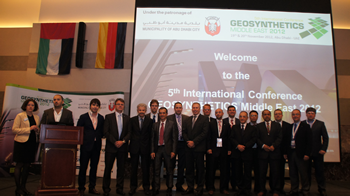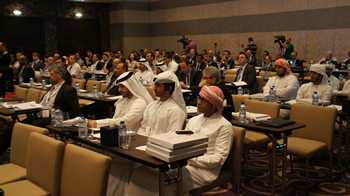 |
Geosynthetics Middle East (November 2012) marked the fifth in this annual series of conferences. One day was devoted to geotextiles, geogrids, and geocells, while another was devoted to geomembranes. Approximately 350 people registered and represented 30 countries including Saudi Arabia, Malaysia, UK, USA, Germany, Switzerland, India, Iran, China, Slovakia, and Poland. There were more than 30 exhibitors. The conference is organized by SKZ (Germany) with the assistance of BMC-Gulf.
The conference has grown steadily over its first five years, in no small part due to the efforts of BMC’s Fabian Beermann who, three years ago, obtained the patronage of the Municipality of Abu Dhabi for the event. The municipality is still involved, and with this relationship we are seeing how geosynthetics are being incorporated into Abu Dhabi’s objective to become a major green city.
Registrants this year included many students from Higher College of Technology and Abu Dhabi University.
 |
The conference was opened by the German Ambassador to the UAE, Nikolai von Schoepff, and the keynote speaker was H.E. Eng Abdulla S. Al Shamsi, Executive Director of Infrastructure and Municipal Assets for the city of Abu Dhabi.
We heard about geogrids in roads (Ahmed Hassan Ali, UAE), automatic monitoring of deformation and subsidence in roads (Jaroslav Ajdukiewicz, Poland), MSE construction for highways (Christian Psiorz, Germany), geotextiles in railroads (Mohammad Baradi, Saudi Arabia), geogrid in pavements (Piergiorgio Racalcati, Italy), geogrid testing (Nigel Wrigley, UK), geocontainers (Angus Jackson, UAE), geocells (Ansgar Emersleben, Germany), geotextile survivability (Khalid Maccai, Saudi Arabia), and separation/stabilization geotextiles (Philippe Grimmelprez, UAE).
On the geomembrane side many found it refreshing to hear about hydraulic applications of PVC including underwater installation and repairing of dam liners from Marco Bachelli of Carpi. Then Helmut Zanzinger (SKZ) presented details of the rapid method of determining stress cracking resistance of HDPE from the strain-hardening portion of the simple uniaxial tensile test stress/strain curve. He also discussed the new autoclave test for assessing the oxidation resistance of HDPE, all with a view to developing a set of specifications for a high durability HDPE geomembrane. This recognizes that GRI.GM13 is a minimum specification. Even so one attendee asked if his country’s locally made HDPE geomembranes would run into durability problems since SCR would not meet GM13’s minimum of 300 hr and government bodies were asking that such specification be relaxed, or people might be put out of work. I was also asked which is the better material for a tunnel liner – PVC or HDPE? I responded that it depends on the application and service conditions. He said, “Yes, I know; but which is the better?”
 |
Catrin Tarnowski (GSE) discussed floating covers and Kent von Maubeuge (NAUE) discussed the incorporation of PE films on GCLs. Markus Haage (Agru) presented information on a novel leak location system for tunnel liners, while Alan Thomson (Abu Dhabi) discussed concrete protection liners in the city’s STEP sewer tunnel project. Daniel Tan (Solmax) presented an evaluation of HDPE geomembrane for coal seam gas fracking and production brine solutions, and Fouad Ashkar (BMC-Gulf) discussed geomembrane material selection, design, and installation.
The day after the conference a few people were given a tour of the STEP sewer tunnel project primarily to see the AKS concrete protection liner being installed on the 6.4 m diameter tunnel walls. We rode an elevator 75 m down the main shaft and walked quite a way along the rail tracks that delivered liner rolls about 13 m long and concrete to the work station. Joints are double wedge fusion welds.
Congratulations to SKZ’s Irina Bender and team for a great learning and social experience in a fascinating part of the world.
More information on Geosynthetics Middle East and future events can be found on www.geosyntheticsme.com and www.skz.de.
Ian D. Peggs, P.E., P.Eng, DABFET is president of I-CORP INTERNATIONAL, www.geosynthetic.com.











